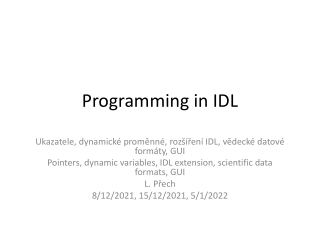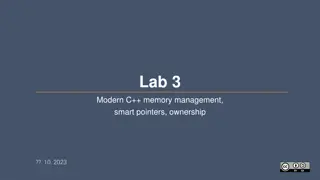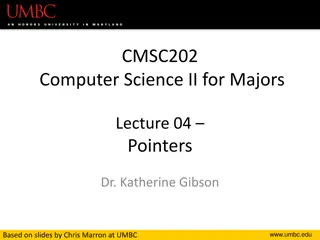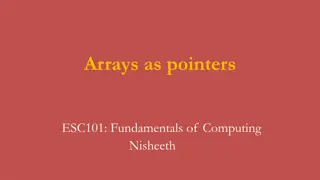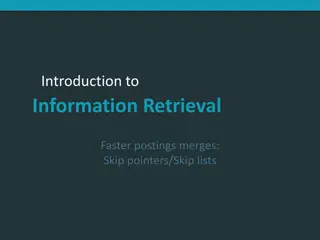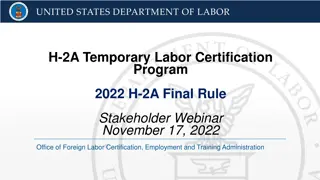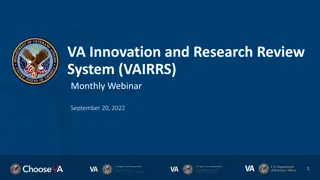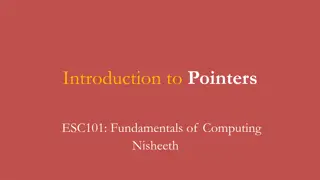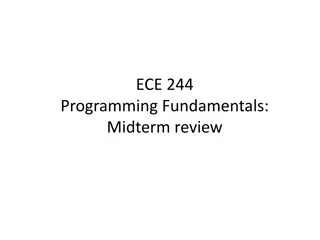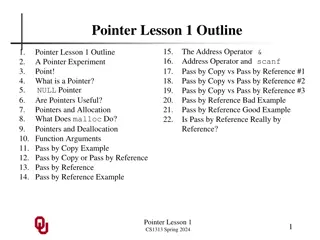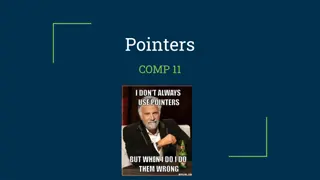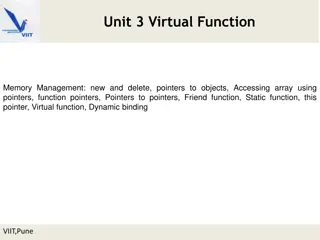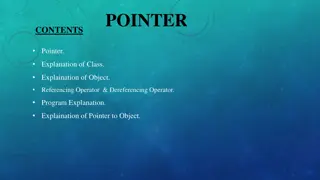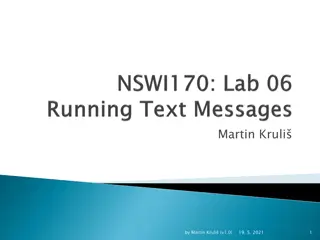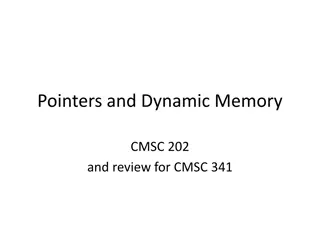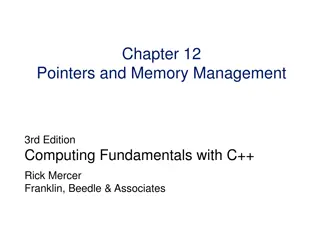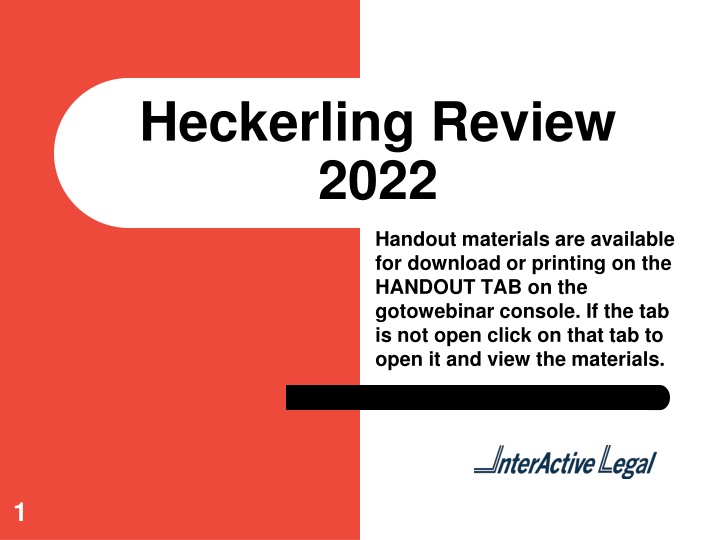
Heckerling Review 2022: Handout Materials and Webinar Pointers
Handout materials for download or printing are available on the HANDOUT TAB on the gotowebinar console. The Heckerling Review 2022 provides valuable insights and information shared by legal experts. The program covers a range of topics related to estate planning, tax implications, and more. Webinar pointers include access to PowerPoint downloads, recordings, and certificates of attendance. A general disclaimer emphasizes the educational nature of the content and encourages seeking professional advice for individual circumstances. Special thanks to LISI for their detailed article on the topic.
Download Presentation

Please find below an Image/Link to download the presentation.
The content on the website is provided AS IS for your information and personal use only. It may not be sold, licensed, or shared on other websites without obtaining consent from the author. If you encounter any issues during the download, it is possible that the publisher has removed the file from their server.
You are allowed to download the files provided on this website for personal or commercial use, subject to the condition that they are used lawfully. All files are the property of their respective owners.
The content on the website is provided AS IS for your information and personal use only. It may not be sold, licensed, or shared on other websites without obtaining consent from the author.
E N D
Presentation Transcript
Heckerling Review 2022 Handout materials are available for download or printing on the HANDOUT TAB on the gotowebinar console. If the tab is not open click on that tab to open it and view the materials. 1
Heckerling Review 2022 By: Abigail O Connor, Esq., Jonathan G. Blattmachr, Esq. and Martin M. Shenkman, Esq. Thanks to Mary Vandenack, Esq. for her assistance with the Leimberg Information Services (LISI) article that was adapted in part for this PowerPoint 2
Some Webinar Pointers The PowerPoint is available for download from the web console during the program. A recording of this program and the materials will be posted to www.shenkmanlaw.com/webinars. There is a growing library of 50+ webinar recordings there. There is a growing library of 150+ video planning clips on www.laweasy.com. There is no CLE or CPE for this program, but you will be sent a certificate of attendance from the webinar system. We cannot control those certificates so if there is an issue we cannot assist. If you have questions, please email the panel. All emails are listed on near the end of the slide deck. 3
General Disclaimer The information and/or the materials provided as part of this program are intended and provided solely for informational and educational purposes. None of the information and/or materials provided as part of this power point or ancillary materials are intended to be, nor should they be construed to be the basis of any investment, legal, tax or other professional advice. Under no circumstances should the audio, power point or other materials be considered to be, or used as independent legal, tax, investment or other professional advice. The discussions are general in nature and not person specific. Laws vary by state and are subject to constant change. Economic developments could dramatically alter the illustrations or recommendations offered in the program or materials. 4
Thank You To LISI Leimberg Information Services, Inc. ( LISI ) has a detailed 110 page article on this topic that subscribers should access. Portions of that article were used/adapted in creating this PowerPoint. 5
Disregarded Becomes Regarded Disregarded entities (LLCs) will almost always become a partnership for income tax purposes, e.g., when grantor dies. Grantor trusts are disregarded during the grantor s lifetime; but on death of grantor of grantor trust disregarded entity becomes a partnership Disregarded LLCs can have more than one member. Two spouses in community property state owning an LLC that may be a disregarded entity if the interest held in LLC is in fact community property. This is so even though spouses are considered two separate taxpayers. If the married couple doesn t currently own community property (e.g., they live in Vermont), they can create community property with an Alaska Community Property Trust. If you are in a separate property state, you cannot be a disregarded entity you will be a partnership. If in community property state initial filing is critical. Must file initially as disregarded entity. If community spouses divorce the disregarded entity becomes a newly created partnership. 7
S Corporation Status for LLC Don t assume a default classification; LLCs and partnership are often taxed as S corporations or C corporations. Only use S corporation for employment tax planning. Authors Note: If the LLC checks the box to be taxed as an S corporation be mindful of the many rules restricting trust ownership of S corporation, etc. Also, many clients erroneously assume that with an S corporation status negligible or no compensation can be paid with the majority of income paid as a distribution to avoid FICA taxes. A safer approach may be to have the client s CPA or an appraiser present a reasonable compensation study to corroborate the compensation that might be sufficient to pay the key employee/owner. 8
Partnership Formation, 721, Investment Company Exception Contributions in exchange for a partnership interest are generally not taxable when contributing property and cash. General rule: contributions of property are generally non-taxable but all tax attributes, including holding period, remain the same. Many security FLPs and LLCs have been formed, and no doubt many more will be formed in the future. Apart from possible valuation discounts, entities are a convenient way to aggregate interests from many smaller family trusts to a large investment entity to obtain access to investment vehicles that might not otherwise be available to the smaller trust/members. Asset protection considerations have driven many of these plans and should continue to do so. Practitioners should be alert to the risks of violating the investment company rules under Code Section 721 and inadvertently triggering gain. These rules are not intuitive, apply rather mechanical tests and those tests should be confirmed (tested) by someone on the planning team before consummating the formation of any entity taxed as a partnership owning primarily securities. See discussion below. Practitioners should also be aware of the publicly traded partnership rules. 9
Tax Allocation is Not Cash Flow Consider Mandatory Tax Distribution Allocation of tax items in most FLPS are usually pro rata according to capital account balances. Allocation does not mean cash flow. Consider a tax distribution clause in the partnership agreement. Without one, partners may have income allocated to them and no cash to cover tax cost. This is sometimes referred to as phantom income. But it may not always be advantageous to mandate a distribution to pay taxes. Even if that approach is agreed to, how can the tax cost of various partners/members be determined? Members may live in different states and have disparate income tax costs. So often some guesstimate/proxy percentage for state and federal taxation may be used. Also, consider the impact if the entity requires cash flow for operations or other pressing matters. Should a tax distribution be mandated no matter what? Some suggest that the phantom income that can be created is a powerful asset protection tool wherein a claimant who would seize a partnership interest would be allocated taxable gain while the partnership entity would withhold distributions thereby creating a negative economic result for a claimant and thereby enhancing asset protection. It is not clear that this concept will function as some suggest. Some asset protection practitioners advise the use of blocker LLC s so that asset protection can be achieved without completing terminating distributions. 10
Recent Developments 2021-2022 11
Biden Greenbook Proposal Key question might it be enacted? Most view as unlikely, but what do practitioners tell clients? What can practitioners suggest to clients? Many clients are frustrated with the ongoing cautions about pending tax law changes that practitioners have been warning about for several years. Do clients even have the interest in hearing about these proposals? On the other hand, whether or not practitioners have any responsibility to inform clients of proposed changes (we think not) it nonetheless may be advisable to do so. Practitioners should consider using e-newsletters, letters enclosed with billing, footers on bills, and other methods to inform clients of the existence of the Biden Greenbook proposals, and perhaps some of the general proposals included. Also, consider cautioning clients as to the obvious fact that there is no certainty as to what might occur, if anything. 12
Biden Greenbook Proposal Billionaires tax. This is really a proposed tax on those with $100M of wealth. Issue for assets with substantial appreciation especially a family business. This may play well with some voters as an effort to tax the super-wealthy. The tax is on unrealized appreciation and perhaps may have a better chance of surviving a constitutional challenge then a pure wealth tax. However, few seem to believe that has much potential of being enacted, although predicting tax law changes is less certain then predicting the weather. It is also not clear what steps practitioners might advise clients that may be affected by this. Might it be possible that shifting wealth into irrevocable trusts may escape the tax assessed on assets held in the taxpayer s own name? 13
Biden Greenbook Proposal Grantor Trust Restrictions Current proposals are very unclear as to what they refer to. Might they refer to: Proposal to include assets in grantor trust in grantor s estate at death. Overturn Rev. Rule 85-13 so gain would be recognized when appreciated assets are sold to what would have been a grantor trust. Changes to grantor trusts may be biggest change proposed. While it is questionable providing any recommendations to clients based on uncertain proposals that may never be enacted, it does seem that, just as noted elsewhere in this outline, that shifting wealth to irrevocable but flexible and accessible trusts prior to changes being made may prove advantageous. If this type of planning provides asset protection, succession planning and other benefits, perhaps there is no downside. This might all be undone with disclaimers. 14
Biden Greenbook Proposal Note valuation consistency. If an asset is sold to a trust for an AFR note, the note is deemed to be valued at face. If years later that note is contributed to an FLP along with other assets, and then FLP interests are sold to another trust, the note as an asset in the FLP might be valued at a discount from face based on the FMV standard of willing buyer/willing seller. The IRS has long wanted to address this whipsaw in valuation of notes. Discussion of limiting donor advised funds as remedies for private foundations that don t want to pay out distributions. Shortening time period for which GST trusts will be protected. This too has been proposed. Phrased oddly. Limitation on duration of GST exemption. This is different (and perhaps better) than saying you cannot do perpetual trusts. NOTE THAT AS DRAFTED, IT WOULD DENY ANY GST TAX PROTECTION IF THE TRUST IS SCHEDULE TO LAST TOO LONG, NOT JUST CUTTING OFF GST TAX EXEMPTION AFTER A PERIOD OF TIME. 15
Valuation Cases - Warne v. Commissioner, T.C. Memo. 2021-17 (Feb. 18, 2021). LLC discounts issue. Took position that lack of control and lack of marketability discounts taken were acceptable on controlling interest in LLCs. IRS seemed to agree. Tax Court said if everyone agrees then we only have to figure out amount of discount. But why was there any discount at all? No marketability discount, but why lack of control? If don t own 100% you don t have total control and must consider other owners who can be a nuisance. Charitable discount issue. No 100% charitable deduction. Measured by what recipient charity received, not what included in estate. Planner should have given 100% to charity to avoid discount issue. Could bequeath entire charitable amount to a DAF (or a private foundation) for example rather than separate charities so that the value would not be discounted. Consider directing sale and distributing cash to avoid destroying value. 16
Valuation - Buck v. United States, 2021 WL 4391091, 128 AFTR 2d 2021-6043 (D. Conn. Sept. 24, 2021). Donor purchased real estate tracts. She gifted 48% of each tract and retained a 4% interest. IRS argued against discounts. Should have valued as if she had held on to them until death. Court disagreed as gift tax value is not based on what donor gives up but rather on what the donee receives. 1993 Rev. Rul. 93-12 - donor gave 20% of corporation to each of 5 children and IRS conceded to discount. Why did the IRS take an opposite position in Buck? No idea. Gifts of undivided interest in real estate to separate donees should be valued separately and not aggregated. Position taken by IRS was different from a previously issued Revenue Ruling 93-12. Court treated Revenue Ruling as a concession by the IRS. Court said that value is based on what donee receives rather than what donor had prior to making gift. 17
Adjustment - Nelson v. Commissioner, 128 AFTR 2d 2021-6532 (5th Cir. Nov. 3, 2021), aff g T.C. Memo. 2020-81. 5th Circuit affirming tax court. Formula clause based value of gift on appraised value. Defined value transfer did not work because incorrect language used (not because the mechanism was faulty). Mrs. Nelson owned 94% interest in a partnership. The IRS didn t agree with valuation done by appraiser and argued on the split gift that $7 million tax owed. Nelsons relied on formula clause based on appraisal and said they should not owe any tax. They lost, not because formula gifts don t work, but because they used the wrong formula. Their formula was keyed to what the appraiser said - not to what the IRS said. Discussion in Court of Appeals and Tax Court implicitly approved use of formula clauses when used properly. When using a formula clause, refer to values as finally determined for gift or estate tax purposes. If the incorrect language was used might it be possible to correct that language as a scrivener s error? If a retroactive correction is made will it be effective? 18
Valuation GRAT CCA 202152018 (issued Oct. 4, 2021; released Dec. 30, 2021). GRATs are the original formula clause. The Regs contain an adjustment mechanism if the annuity payment is specified as a percentage of the value of the asset not a fixed dollar amount. Keep percentage of initial contribution that based on the end of the term there is something left you can determine in advance. If the value put into GRAT is much more if you have a formula annuity payment it should not matter. GRAT was reasonably structured, but appraisal was 7 months old. How bad is 7 months? Appraisal was prepared for Section 409A purposes. But CEO/Taxpayer knew at the time the company was being shopped, something the appraiser did not know. Company was sold for 3 x the appraised value. IRS might have said well the annuity should be greater as the value was wrong and the GRAT adjustment mechanism should be triggered. But the IRS took a more radical approach because they viewed the appraisal as egregious, or perhaps more so that the taxpayer was not ethical using an old appraisal when he knew the company was being sold for much more. There was an intervening appraisal and gift to a charity with an inconsistent value and the IRS concluded that the taxpayer was trying to game the system. 19
Valuation GRAT CCA 202152018 (issued Oct. 4, 2021; released Dec. 30, 2021). Under Atkinson - Atkinson v. Commissioner, 115 T.C. 26 (2000), aff d, 309 F.3d 1290 (11th Cir. 2002) a CRT was challenged for not complying with the terms of the Regs. GRAT Regs are similar to CRT Regs. Based on an application of Atkinson, the GRAT failed. Valuation should take into consideration a pending merger. GRAT annuity treated as not being a qualified interest under Section 2702 because of undervalued appraisal (by analogy to Atkinson). Some have read the CCA as suggesting that a valuation that is 7 months old is not acceptable. That may be, but the real issue in the CCA was that the taxpayer was playing games. The taxpayer knew that there was a significant development subsequent to the appraisal and he hid that. So, while practitioners might question the validity of a stale appraisal, the bigger issue is proper disclosure. Perhaps a belt and suspenders should be used on funding GRATs with a defined value mechanism on the assets gifted to the GRAT so that the adjustment occurs outside the GRAT mechanism. Another consideration for planners is whether GRATs should continued to be used in valuation adjustment spillover mechanisms as a receptacle. Might a DAF or incomplete gift trust now be better options than a GRAT? 20
Smaldino v. Commissioner, T.C. Memo. 2021-127 (Nov. 10, 2021). Step transaction issue, and much more. Gift from husband to wife was disregarded and treated as a taxable gift by husband to trust. Because husband and wife had not split gifts, this was a gift all from husband to trust. Some of the documents were not dated with the signature date. These documents simply referred to effective date. Formalities of admission of Mrs. Smaldino to LLC were not followed. Nothing ever showed Mrs. Smaldino as a member of the LLC. Appraisal was after the gift and appraisal came to exact same value as was used for gift. The results of this case should be considered in SLATs where a conclusion could pose significant issues if donor is also a beneficiary. There are a myriad of take home lessons from Smaldino. The case should not be viewed merely as a bad fact case and dismissed or limited to being a step transaction case. The case provides a valuable checklist of many of the formalities and steps that should be observed in all estate planning transactions. 21
Smaldino v. Commissioner, T.C. Memo. 2021-127 (Nov. 10, 2021). Assure consistency of income and gift tax reporting and the transaction documents with the intent for the transaction. Have the records of the trustee been reviewed to assure that they properly reflect the transaction? It is not uncommon for one or more of the advisers to report the transaction as a transfer of the estimated interests rather than as a transfer of a fixed dollar amount. Another consideration of the case is step-transaction concerns. When spouses have a joint account is anything done to divide those assets before a gift is made? In many cases no. Further, it is common for practitioners not to report a gift on Form 709 between spouses if that was necessary to divide the joint account before one spouse made a gift. Perhaps the lack of documentation and formality in this regard should be reconsidered. So, if husband is making a gift to a SLAT of funds taken from a joint account (many clients do not maintain separate accounts) perhaps there should be the formality of a gift document signed by wife to husband to confirm that the assets were husbands. And perhaps that gift should be reflected on a gift tax return. 22
Incomplete Gift Non-Grantor Trusts (INGs) You might be better off in some cases having non-grantor trust. In Rev. Proc. 2020-3 IRS said it will no longer issue favorable ING rulings unless you follow specific requirements. But then in 2021 IRS said it won t issue PLRs on INGs at all. This was again stated in Rev. Proc 2022-3. Rev. Proc. 2021-3, 2021-1 I.R.B. 153, Section 5.01(9), (10), (15) & (17) (Jan. 4, 2021). In some situations, a non-grantor trust might be preferable. Each trust if not subject to the multiple trust rule gets a $10,000 SALT deduction, 199A deduction, etc. Also, a non-grantor trust may be used to avoid state income taxation. 60 PLRs issued on INGs. No gift tax in the traditional incomplete gift trust. You could also get the property back as you the grantor are included in the class of beneficiaries. Attributes change in IRS policy to an article by Professor Couch. Can you still do an ING? Should you? 23
Incomplete Gift Non-Grantor Trusts (INGs) While IRS could retroactively revoke the 60 PLRs going back to 1990. What about on a prospective basis? McKinney an 11th Circuit case. Notes that PLRs cannot be cited as precedent, but they can be used as authority. If IRS changes its mind it will likely do so on a prospective basis. Could state in trust Grantor intends that this is not a grantor trust and grantor also does not want her transfer to be a completed gift. If grantor cannot achieve both of these goals then state the default you want. Law in the US is when you ascertain the intent of the grantor you must construe the trust in that manner. Estate of Reid 1982 Tax Court case said because Mrs. Reid did not intend assets to be included in her estate that trust should be construed in that manner. NY adopted an anti-ING rule. One has been proposed for California. Speakers - one does them without rulings. But now that they are not ruling on them another speaker is concerned that perhaps that might be too risky. 24
QTIP Planning - 1 Recent PLRs: QTIP Trust Division Followed by Modification: PLR 202116001 QTIP Trust Division Followed by Disclaimer: PLR 202146001 Options to plan for QTIP. #1. Gift by spouse of part or all of her income interest. Issue is that if there is a spendthrift clause may not be able to distribute out QTIP. But may be able to amend it. This is a gift of not only the income interest but under Sec. 2519 it is treated as a gift of the entire value of the QTIP including the remainder interest. Gift tax value of deemed remainder is calculated as a net gift as spouse making gift can recover estate tax obligated to pay. Not necessarily a bad approach. Surviving spouse might be able to use exclusion before it drops in 2026 and freezes value of assets in QTIP. Weigh this against loss of basis step-up. Spouse can surrender portion of income interest without triggering tax on all of interest. Answer is to divide the QTIP before making the gift. Relinquishment of interest in one trust won t be treated as relinquishment in another trust. 25
QTIP Planning - 2 #2 Sale by spouse of part or all income interest. But adverse income tax consequence that sale triggers income tax but under Section 1001(e), the basis of income interests when disposed of by sale is zero. #3 Purchase by spouse of remainder interest. If spouse buys remainder interest in the QTIP you cannot keep the remainder interest out of the spouse s estate but you have depleted the value of the estate by the payment made for the remainder interest. Rev. Rule 98-8 treated as termination of income interest triggering a gift tax (see Section 2519) and consideration of getting back remainder interest was not treated as full consideration in money or money s worth as it did not augment her estate. 26
QTIP Planning - 3 #4 Commutation of QTIP by taking actuarial interest. QTIP Trust Commutation and Reciprocal Gift: CCA 202118008. Commute interests. Net gift by spouse. Remainder beneficiaries won t be treated as making gift as in CCA. Freezes value of trust assets. Possible adverse income tax consequences. 201932001 PLR IRS took position that a similar transaction should be viewed as a purchase of income interest by remainder beneficiaries under Section 1001(e). Speaker believes PLR is wrong. Is there a way around this? Avoid income tax problems if instead of terminating the trust, have the income beneficiary and remainder beneficiaries transfer interests in the trust to a partnership and rely on Section 721(a) saying no gain on transfer. In future surviving spouse may transfer partnership interest and may be able to use basis in partnership interest to avoid income tax except on appreciation. Be sure that under state law this does not cause a merger of interests. A merger would terminate the QTIP. Might have different trustees etc. to avoid merger. 27
QTIP Planning - 4 #5 Distribution of QTIP property to spouse to do own estate planning. This is most popular approach but depends on trust agreement giving the trustee sufficient latitude to make distributions. Consider incorporating into the governing instrument the authority and right to allow distributions of principal to spouse to engage in estate planning. Issue to worry about 2013 case of Kite v. Commr. In Kite, distribution made to spouse and as part of preconceived plan, spouse then sold those assets to a trust for children. Tax Court held that was essentially a communication by the surviving spouse and she had to pay tax on remainder interest she got back. Purchase price was a deferred annuity. Be sure that there is a lot of time between distribution and implementation of an plan. 28
Wellin Malpractice Case $100M+ of Berkshire Hathaway. Put into LP and sold LP units to a grantor trust. Wellin did that and children controlled the partnership and sold the partnership assets. When Wellin did the sale, the underlying stock was $150M and note was $50M. That appears to be a tremendous estate tax result. Turns out that Mr. Wellin was not happy with the arrangement and sued to have it undone. Sued lawyer for negligence and more. Taxpayer claimed lawyer never advised him of the risk. And trust was partner in partnership and partnership sold BH Stock and gain was attributed and passed gain back to Mr. Wellin of a huge gain. Taxpayer claimed he was unhappy about this. Why was client upset with such a great estate tax result and the tax burn which is the best attribute of a grantor trust under 2004-64 grantor gets tax bill and trust can grow free of income tax the most powerful factor in all of financial planning. Trial in upstate NY and 4th Circuit US Court of Appeals decided that his claim against lawyer had not run by the statute of limitations. Lawyers wanted case dismissed for running of statute of limitations. Court s narrow holding was that statute had not run. Planners speaking to clients should advise clients that income earned in the trust will trigger tax on which the grantor is liable. Rev. Rul. 2004-64 can use tax reimbursement but it can possibly cause estate inclusion. 29
Wellin Malpractice Case - Lessons Whenever doing a transaction, tell the client all the consequences that could happen. Warn them. Send them a letter or written memo that explains the transactions in non-legalese, outline the reasons for doing the transaction, and also outline the potential risks and consequences. Create a template disclaimer that could be placed on the top of every memorandum that highlights the general risks of all estate tax planning, the requirements or expectations from the client, etc. This is no different than the standard disclaimers every financial firm appends to any analysis. Why aren t more lawyers using similar precautions? Consider including or expanding language in retainer agreements signed by clients stating that there are no guarantees to any planning and any possible positive result will almost always have an offsetting negative implication. Another step some may consider is developing a risk factor checklist, akin to the risk factors section in a private placement memorandum, that alerts clients to a range of common risks in any estate plan. Better yet that risk factors might be tailored to reflect the particular transaction involved. 30
Wellin Malpractice Case - Lessons If clients are going to claim (whether factually correct or not) that they were not informed of risks, perhaps the message is that we as practitioners should be certain that they cannot say that they were not warned of risks. And when that is done in writing it is even more difficult for the client to deny such disclosures were made. Practitioners should also be alert to family dynamics. It is not possible to know in Wellin what the attorney could have known about family dynamics but from the case itself it appears that there were significant issues amongst family members. Caution should be exercised in identifying and addressing conflicts of interest in any family representation. Perhaps a standard conflict disclosure can be added to all retainer agreements and tailored to address each family s situation. Again, we cannot know what actually happened in Wellin from the limited discussion in the case but using it as a warning to be even more careful in protecting ourselves is likely a prudent take-away. 31
Levine Case Economic Benefit Split-Dollar - 1 This case involves a split-dollar life insurance arrangement. Marion Levine (Levine) entered into a transaction in which her revocable trust advanced funds that the ILIT used to pay premiums on life insurance policies taken out on her daughter and son-in-law. These policies were purchased and held by a separate and irrevocable life-insurance trust that was settled under South Dakota law. Levine s revocable trust had the right to be repaid under the split- dollar agreement for the greater of the cash value of the policies or the premiums. Decisions for investments within the irrevocable life-insurance trust, including for its termination, could be made only by its investment committee, which consisted of one person Levine s long-time friend and business partner, Larson. Levine died, and the policies had not terminated or paid out at that time as her daughter and son-in-law were still living. The question was what has to be included in her taxable estate because of this transaction: (1) the value of her revocable trust s right to be repaid in the future (i.e., $2,282,195), or (2) the cash-surrender values of those life-insurance policies at the time of Levine s death (i.e., $6,153,478)? 32
Levine Case Economic Benefit Split-Dollar - 2 The split-dollar arrangement in this case met the specific requirements of the Treasury Regulations. The policies in question were purchased and owned by the irrevocable trust, not Levine, and the arrangement expressly gave the power to terminate only to the trust s investment committee. Thus, neither IRC Section 2036(a)(2) the general catch-all statute for estate assets nor Section 2038 the claw-back provision for certain estate assets transferred before death do not require inclusion of the policies cash-surrender values because Levine did not have any right, whether by herself or in conjunction with anyone else, to terminate the policies. The transaction was not merely a scheme to reduce Levine s potential estate- tax liability and there was a legitimate business purpose. There was nothing behind the transaction s fa ade that would suggest that appearance of the express written terms of agreement and arrangement do not match reality. The court was impressed that the attorney and family evaluated the need for the children to have planning and life insurance and that there were valid reasons for the insurance apart from the impact on Mrs. Levine s estate. 33
Levine Case Economic Benefit Split-Dollar - 3 Pursuant to applicable state law, the trust s investment committee one person owed fiduciary duties to the trust and beneficiaries other than Levine, Levine s daughter, and son-in-law, and the evidence illustrated that the written agreements afforded Levine no power to alter, amend, revoke or terminate the irrevocable trust such that its assets should be included in Levine s estate pursuant to Sections 2036(a)(2) or 2038. The only asset from the split-dollar arrangement that Levine s revocable trust owned at the time of her death was the split-dollar receivable. Make sure the trustee doesn t have another fiduciary relationship. In the Levine case Larson, who was the investment committee for the ILIT was also a co-agent under Mrs. Levine s power of attorney with her two children. The IRS argued that this put him on both sides of the transaction, similar the Cahill case which was a taxpayer split-dollar loss. When planning a similar transaction endeavor to avoid any overlap of fiduciary roles. Was there a gift at inception when Mrs. Levine advanced $6.5M and it was valued at about $2M? 34
Levine Case Economic Benefit Split-Dollar - 4 Section 2036(a)(2) same argument as Morrissette. Advancer of premiums and party getting death benefit could terminate the arrangement. It was in the contract between the decedent and other party to the transaction the taxpayer had the right to control beneficial enjoyment in conjunction with another person. In Levine, no express statement that parties could get together and terminate. But as a matter of state law you can do a novation. Court in Levine did not accept this argument. They did this on the basis of two cases: Hemholz: Supreme Court case held ability granted under state law to terminate something is not the power to control beneficial enjoyment of property. See also Estate of Tully. ILIT trustee also was the grantor s co-agent under her Power of Attorney. This comes out of Strangi case. Levine Court said it does not apply. In Strangi person who held property was son-in-law. The positions Larson held as agent and investment committee may have been a close call and the better approach is not to risk this. Also, which the Levine Court did not discuss, Larson was a business partner and perhaps employee of the Levine family. How different was this situation really than the facts in the Cahill case in which the son s cousin and business partner was the ILIT trustee? 35
Levine Case Economic Benefit Split-Dollar - 5 2703 Court ruled out that there was no restriction. Mrs. Levine could remove, but insurance was not held by her. IRS can argue that if you can get back asset you should be sure person has no other fiduciary relationship like attorney-in- fact so you can close off the argument. Make it an independent person to be there who has fiduciary duty to beneficiaries of the trust and the Levine Court noted this in the case. The only asset Mrs. Levine s estate held was the rights under the split-dollar agreement. She never had rights in the insurance policies as she never held any interests in them. So, the Regs under 2703 could not apply to disregard a restriction as to the insurance as she never held any rights to the insurance. Levine Court told IRS it should rewrite its split-dollar regulations to change gift tax consequences on valuation of gift tax regulations. 36
Corporate Transparency Act Tries to prevent money laundering. Applies to entities required to file with state, such as LLCs, corporations, etc. Will create massive reporting headaches for entities often used in estate planning. Will create a national registry of beneficial ownership of reportable entities. This act requires more robust disclosure of direct and indirect ownership of private companies and raises some concerns about trusts. When regulations become effective, existing entities will have one year to comply. For entities formed after regulations become effective, you must comply in FOURTEEN days, which is very little time. Reporting Company corporations, LLCs, and other similar entities created by filing a document with a secretary of state or similar office, as well as entities formed outside of the US that are registered to do business in the United States. 37
Secure Act Regs Using NIMCRUT to Mimic Stretch Real change of Secure Act was to eliminate slow payout the stretch for most beneficiaries. Only plan participant and spouse get the stretch (plus a few other specified EDBs). How do you get the benefit of slow payout from plan when it is no longer permitted? Answer is to consider having funds paid to an income only with make-up Charitable Remainder Unitrust (NIMCRUT). It will have to be paid out in 5 years. Have entire IRA paid to a NIMCRUT. CRTs are exempt from income tax. So immediately following death pay IRA to CRT and no income tax will be incurred. NIMCRUT can pay out up to 11% if 20-year term. By having funds put into an LLC with sole member the NIMCRUT the IRA proceeds will be distributed to LLC and income will be attributable to CRT and CRT pays no tax. NIMCRUT is obligated to pay lesser than unitrust amount (which can be as much as 11% for 20 years) or FAI. You can pay out nothing as income NIMCRUT has will depend on distributions it receives from the LLC of which the NIMCRUT is sole member. There is no FAI until the LLC makes distributions out to the NIMCRUT. 38
Errors We All Make Them 39
Apologizing for Identified Error? Cognitive Dissonance can occur when we know we are wrong but want to be right. Sincere apology no blaming. The long-term effect of apologizing allows better long term relationships. Elements of a good apology: Accepts responsibility for the wrong and doesn t hint that outside forces, or the victim, caused the offender to do what they did. It s unqualified. If the apology contains a but , it fails. It offers to make amends. Ethics rules do not require an apology. Rule 1.4 Communications This rule extends to mistakes. There is a duty to keep the client informed so that the client can make informed decisions. A lawyer may not withhold information to serve the lawyer s own interest or convenience. Disciplinary matters. An apology is not necessarily an admission of liability for disciplinary purposes. It can be seen as a mitigating factor in disciplinary proceedings. Short answer If you make an apology, do not admit fault. This can be used against you. 40
Audits Sometimes, they are even fun 41
Prep for Audit Prepare for audit. Be sure to have non-tax reasons for forming partnership. IRS is making broad requests. Be aware of privileges. IRS asks for the entire file on audit. Are files privileged? Client and attorney must preserve at estate planning level. If client shares communications with third parties, then privilege won t exist. Emails can be subpoenaed on audit and in litigation. You may have to testify as an estate planning attorney as to the reasons for creating an entity because the client may no longer be alive to do so. In most trials, the courts have put attorney on witness stand to testify as to non- tax reasons for the entity as in the estate tax case the taxpayer is deceased. Try to discuss non-tax reasons for plan in memos. 42
Defined Value Mechanisms Potential Donees of the Excess Amount Under Adjustment Formula Clause. Public Charity/Donor Advised Fund Independent Fiduciary Obligation Charity must report to state s attorney. general and Internal Revenue Service. Subject to private inurement and excess benefit rules. McCord, Hendrix, Petter. Private Foundation Self-dealing, and excess business holdings can make this an issue. Lifetime QTIP GRAT Is this smart after the recent CCA? If have QTIP or GRAT on back end, use different trustees to have independence. 43
Note Sale Transactions Note received on sale. IRS argues 7872 is not a safe harbor for note at AFR. It is only an interest rate safe harbor and there are other factors to consider in determining value of note such as lack of security, lack of covenants, balloon payment at maturity. All these may create risk premiums that require adding a premium to the base line AFR. The IRS is trying to relitigate the True case. This is an argument from the national office. How avoid this? Make note as commercially reasonable as possible. Consider security. Pay some over time. Attorney John Porter believes this is a losing argument for the government. 44
Powell and 2036 Do not allow senior family member to have unlimited discretion in making distributions. Use a business judgement reasonable discretion standard. Use standards such as needs to preserve assets. Powell case Partnership created under POA 9 days before death. Decedent in conjunction with other partners could dissolve partnership and could control timing of distributions. To avoid Powell 2036(a)(2) vote with other partners, satisfy bona fide sale test for full and adequate consideration you avoid 2036 and 2038. Consider 2 membership interests, one who cannot vote. Or have senior family member dispose of all interests in the entity more than 3 years before death. If no 2036 string within 3 years of death than 2036 doesn t apply. Allen case looked at this issue. Best advice is only a small sliver of interest dispose of it. Could also terminate the interests before death. 45
Private Foundations . 46
Private Foundation Self-Dealing General principles. Assume all transactions are forbidden as a default. Do not assume an arm s length financial transaction with a disqualified person is permissible, it is not. Don t focus on the detriment to the PF or the benefit to the disqualified person, just focus on existence of the transaction. If you rely on an exception to a self-dealing category assume it will be strictly construed. Get a PLR if you can. Disqualified persons can provide stuff to PF for free. Anything a PF provides to a disqualified person is likely a problem. Six Categories of Self-Dealing Payments to Government officials Sale, Exchange or Leasing of Property IRC 4941(d)(1)(A) There is an estate administration exception Lending of Money or Other Extension of Credit Furnishing Goods, Services, or Facilities Payment of Compensation or Payment or Reimbursement of Expenses Transfer to, or Use By or for the Benefit of, a Disqualified Person o o o o o o o o o o 47 o o
Private Foundation Self-Dealing Disqualified Persons super fiduciary at to PF. PF Funder Substantial Contributors Once a substantial contributor, always a substantial contributor unless no contribution or involvement for over 10 year. Foundation Managers Officer, director, trustee of foundation Individual with similar powers Person having authority or responsibility More than 20% Owner of substantial contributor Family Members Spouse, ancestors, children, grandchildren, great grandchildren, spouses of the foregoing, NOT siblings and cousins 35% Entities. If you control 35% of an entity, that entity is deemed to be controlled by you, and therefore that entity will be treated as disqualified person if you are a disqualified person. This is stricter than just control. Sec. 4946. o o o o o o 48
Elective Share, Community Property . 49
Elective Share, Community Property, Etc. Some states provide that a surviving spouse can take a share of a decedent s estate regardless of the will provisions. The majority of the states are elective share states. The remaining states (other than Georgia) have community property regimes. Some states have amounts that provide for support of spouse and minor children. State rules can vary dramatically. Elective share rules serve as restrictions on disposition of one s estate. Elective share rules generally allow surviving spouse to choose between 1/3 and of the deceased spouse s property and applies in both testate and intestate situations. Augmented estate model includes non-probate as well as probate assets. Not all states use augmented estate model. 9 states include more than probate assets but less than a fully augmented estate. 50

